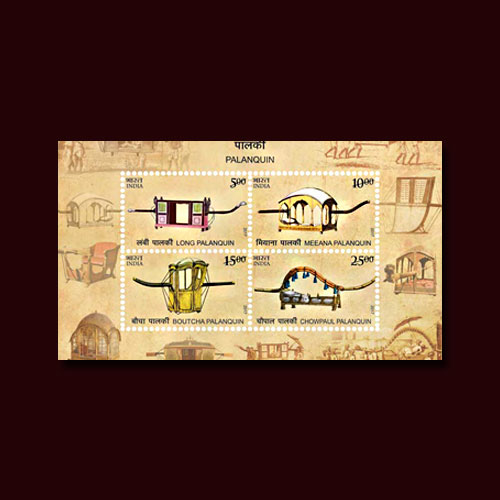Means of transport through the ages on stamps - part I
2019-11-12 Tue
By land, by air, or by water! What’s your favourite transportation system? The history of transport is not only one of technological innovations but also of mobility that brought out human progress. Advances in technology have allowed people to travel farther, explore more territory, and expand their influence over larger and larger areas.Understanding the need and the importance of various transportation systems in our country, India Post had released its mega stamp issue on means of transport on 25th March 2017.This “Means of Transport through the ages on stamps” includes 20 stamps,six sheetlets and four miniature sheets.
Today we are looking at the first amongst this evolution of transport on stamps is the “wheel-less vehicles” more commonly known as “palkhis” in India. These covered litters are usually for one passenger, carried by bearers. It was a type of human-powered transport. The word is derived from the Sanskrit “palyanka”. The palkhis vary in size and grandeur.
The four stamps depict a different variety of palkhis on them. A “Lambi Palki” or a “Long Palanquin” which is open on two sides is depicted on 5 Rupee stamp. The second 10 rupee stamp depicts a “Meeyana Palki” which is a Palanquin open on all sides. A “Boutcha Palki” which is open on four sides and has a comfortable chair is depicted on 15 rupee stamp. The fourth stamp of 25 rupees depicts a “Chaupal Palki” or a “Chowpaul Palanquin” open on the sides and is more of a porter carried “bed”.
Latest News
-
Malwa Sultan Mahmud Shah Silver Coins
2025-09-11 ThuMalwa Sultan Mahmud Shah minted silver coins in round and square flans. <br><br> For round coins,...
-
Malwa Sultan Mahmud Shah Billon coin
2025-08-26 TueMalwa Sultan Mahmud Shah's billon coins followed three weight standards: 100 rati, 96 rati, and 80 r...
-
Fascinating Archaeological Facts on Postage Stamps - 91
2025-08-23 SatRhinoceros is one of the oldest land mammal species existing in India. There are five species of rhi...
-
Fascinating Archaeological Facts on Postage Stamps - 90
2025-08-23 SatUthiramerur, a Village in Kanchipuram, Tamil Nadu, is notable for its Temple inscriptions that descr...
-
Fascinating Archaeological Facts on Postage Stamps - 89
2025-08-21 ThuThe term “millet” is derived from the Latin word “milum,” which translates to grain. millets...

